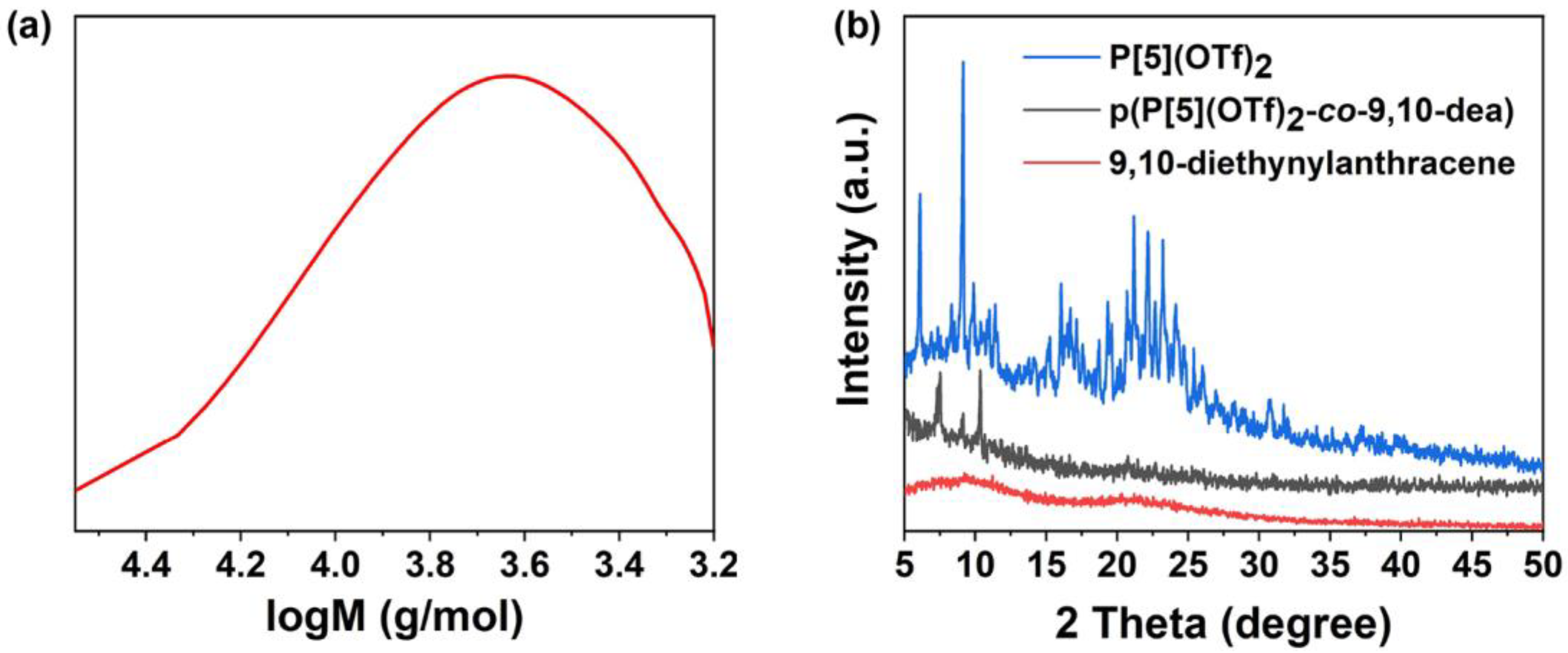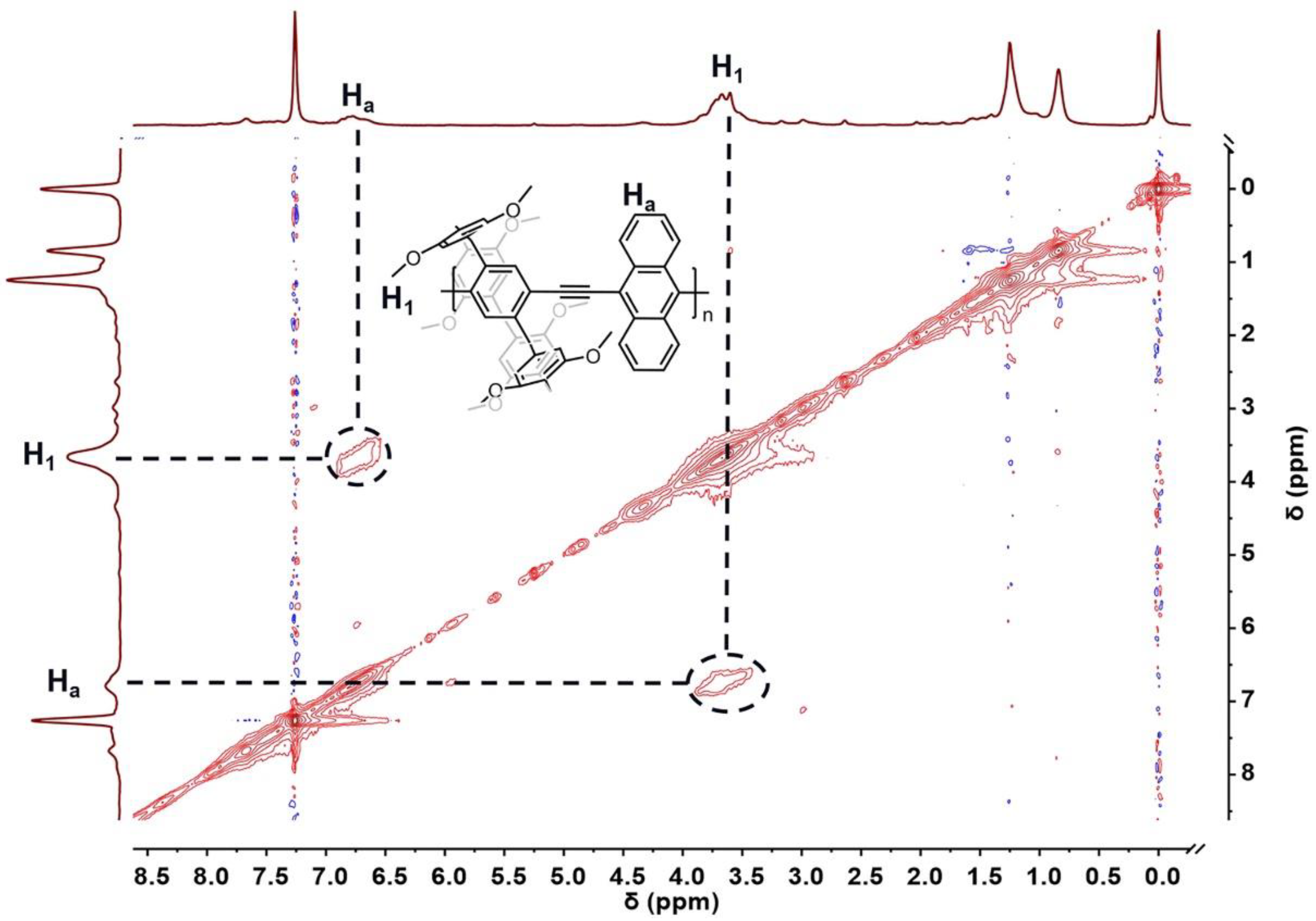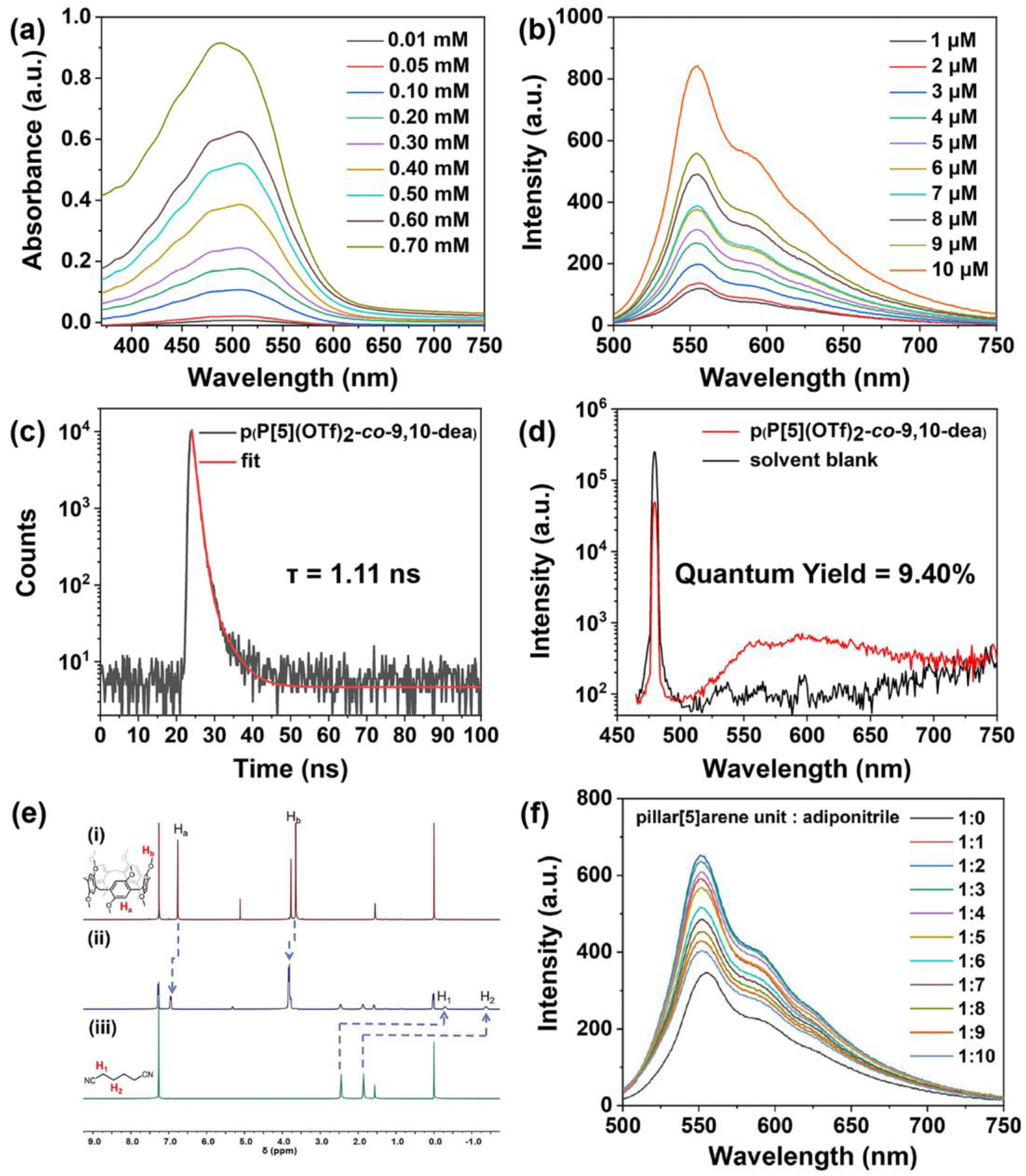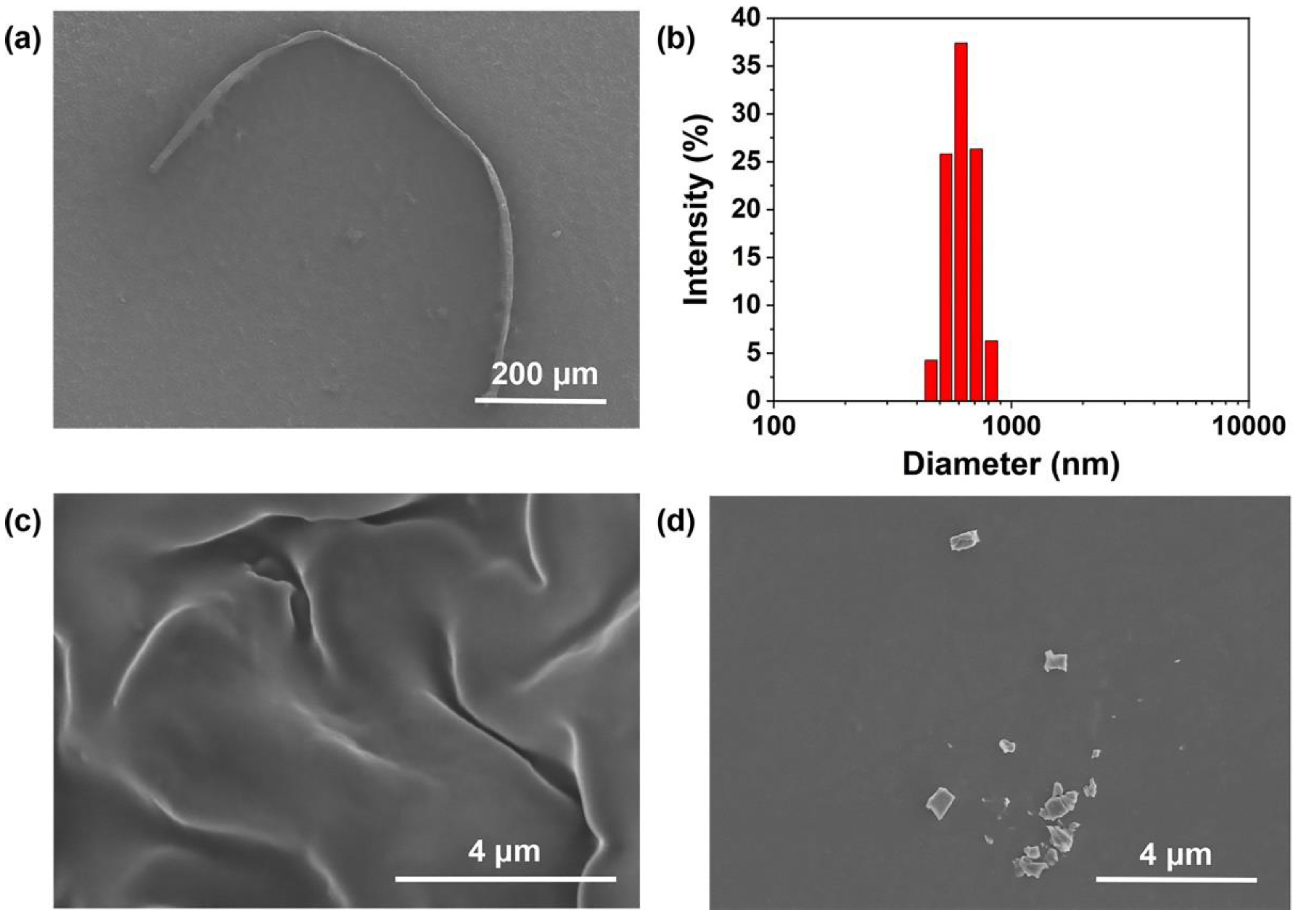A Fluorescent Linear Conjugated Polymer Constructed from Pillararene and Anthracene
Abstract
1. Introduction
2. Results and Discussion
2.1. Polymerization
2.2. Structural Characterization
2.3. Fluorescence Properties
2.4. Tunable Morphologies Induced by Concentration
3. Materials and Methods
3.1. Materials
3.2. Physical Characterization and Techniques
4. Conclusions
Supplementary Materials
Author Contributions
Funding
Institutional Review Board Statement
Informed Consent Statement
Data Availability Statement
Conflicts of Interest
Sample Availability
References
- Li, Z.; Li, L.; Wang, Y.; Yang, Y.-W. Pillararene-enriched linear conjugated polymer materials with thiazolo [5,4-d]thiazole linkages for photocatalysis. Chem. Commun. 2021, 57, 6546–6549. [Google Scholar] [CrossRef] [PubMed]
- Cui, W.; Tang, H.; Xu, L.X.; Wang, L.Y.; Meier, H.; Cao, D.R. Pillar[5] arene-Diketopyrrolopyrrole Fluorescent Copolymer: A Promising Recognition and Adsorption Material for Adiponitrile by Selective Formation of a Conjugated Polypseudorotaxane. Macromol. Rapid Commun. 2017, 38, 1700161. [Google Scholar] [CrossRef] [PubMed]
- Ma, Y.J.; Chen, L.; Li, C.; Mullen, K. A fishing rod-like conjugated polymer bearing pillar[5] arenes. Chem. Commun. 2016, 52, 6662–6664. [Google Scholar] [CrossRef] [PubMed][Green Version]
- Hou, J.H.; Huo, L.J.; He, C.; Yang, C.H.; Li, Y.F. Synthesis and Absorption Spectra of Poly(3-(phenylenevinyl)thiophene)s with Conjugated Side Chains. Macromolecules 2006, 39, 594–603. [Google Scholar] [CrossRef]
- Hou, J.H.; Yang, C.H.; He, C.; Li, Y.F. Poly [3-(5-octyl-thienylene-vinyl)-thiophene]: A Side-chain Conjugated Polymer with Very Broad Absorption Band. Chem. Commun. 2006, 8, 871–873. [Google Scholar] [CrossRef]
- Li, Z.; Yang, Y.W. Macrocycle-Based Porous Organic Polymers for Separation, Sensing, and Catalysis. Adv. Mater. 2022, 34, e2107401. [Google Scholar] [CrossRef]
- Li, Z.; Yang, Y.-W. Conjugated macrocycle polymers. Polym. Chem. 2021, 12, 4613–4620. [Google Scholar] [CrossRef]
- Lou, X.-Y.; Yang, Y.-W. Pyridine-Conjugated Pillar[5] arene: From Molecular Crystals of Blue Luminescence to Red-Emissive Coordination Nanocrystals. J. Am. Chem. Soc. 2021, 143, 11976–11981. [Google Scholar] [CrossRef]
- Yu, D.X. Light-emitting devices with conjugated polymers. Int. J. Mol. Sci. 2011, 12, 1575–1594. [Google Scholar] [CrossRef]
- Tuncel, D.; Demir, H.V. Conjugated polymer nanoparticles. Nanoscale 2010, 2, 484–494. [Google Scholar] [CrossRef]
- Wasielewski, M.R. Self-Assembly Strategies for Integrating Light Harvesting and Charge Separation in Artificial Photosynthetic Systems. Acc. Chem. Res. 2009, 42, 1910–1921. [Google Scholar] [CrossRef] [PubMed]
- Song, N.; Lou, X.-Y.; Hou, W.; Wang, C.-Y.; Wang, Y.; Yang, Y.-W. Pillararene-Based Fluorescent Supramolecular Systems: The Key Role of Chain Length in Gelation. Macromol. Rapid Commun. 2018, 39, e1800593. [Google Scholar] [CrossRef] [PubMed]
- Wang, X.-H.; Song, N.; Hou, W.; Wang, C.-Y.; Wang, Y.; Tang, J.; Yang, Y.-W. Efficient Aggregation-Induced Emission Manipulated by Polymer Host Materials. Adv. Mater. 2019, 31, e1903962. [Google Scholar] [CrossRef] [PubMed]
- Wu, M.X.; Wang, X.; Yang, Y.W. Polymer Nanoassembly as Delivery Systems and Anti-Bacterial Toolbox: From PGMAs to MSN@PGMAs. Chem. Rec. 2018, 18, 45–54. [Google Scholar] [CrossRef]
- Li, Q.Y.; Wu, Y.H.; Lu, H.G.; Wu, X.S.; Chen, S.; Song, N.; Yang, Y.-W.; Gao, H. Construction of Supramolecular Nanoassembly for Responsive Bacterial Elimination and Effective Bacterial Detection. ACS Appl. Mater. Interfaces 2017, 9, 10180–10189. [Google Scholar] [CrossRef]
- Lou, X.Y.; Song, N.; Yang, Y.W. Fluorescence Resonance Energy Transfer Systems in Supramolecular Macrocyclic Chemistry. Molecules 2017, 22, 1640. [Google Scholar] [CrossRef]
- Song, N.; Lou, X.-Y.; Yu, H.; Weiss, P.S.; Tang, B.Z.; Yang, Y.-W. Pillar[5] arene-based tunable luminescent materials via supramolecular assembly-induced Förster resonance energy transfer enhancement. Mater. Chem. Front. 2020, 4, 950–956. [Google Scholar] [CrossRef]
- Guo, S.W.; Song, Y.S.; He, Y.L.; Hu, X.Y.; Wang, L.Y. Highly Efficient Artificial Light-Harvesting Systems Constructed in Aqueous Solution Based on Supramolecular Self-Assembly. Angew. Chem. Int. Ed. Engl. 2018, 57, 3163–3167. [Google Scholar] [CrossRef]
- Wu, J.-R.; Yang, Y.-W. New opportunities in synthetic macrocyclic arenes. Chem. Commun. 2019, 55, 1533–1543. [Google Scholar] [CrossRef]
- Xia, D.Y.; Wang, P.; Ji, X.F.; Khashab, N.M.; Sessler, J.L.; Huang, F.H. Functional Supramolecular Polymeric Networks: The Marriage of Covalent Polymers and Macrocycle-Based Host-Guest Interactions. Chem. Rev. 2020, 120, 6070–6123. [Google Scholar] [CrossRef]
- Ogoshi, T.; Kanai, S.; Fujinami, S.H.; Yamagishi, T.; Nakamoto, Y. para-Bridged Symmetrical Pillar[5] arenes: Their Lewis Acid Catalyzed Synthesis and Host–Guest Property. J. Am. Chem. Soc. 2008, 130, 5022–5023. [Google Scholar] [CrossRef] [PubMed]
- Shao, L.; Pan, Y.T.; Hua, B.; Xu, S.D.; Yu, G.C.; Wang, M.B.; Liu, B.; Huang, F.H. Constructing Adaptive Photosensitizers via Supramolecular Modification Based on Pillararene Host-Guest Interactions. Angew. Chem. Int. Ed. Engl. 2020, 59, 11779–11783. [Google Scholar] [CrossRef] [PubMed]
- Li, Z.; Yang, Y.-W. Functional Materials with Pillarene Struts. Acc. Mater. Res. 2021, 2, 292–305. [Google Scholar] [CrossRef]
- Tan, L.-L.; Yang, Y.-W. Molecular recognition and self-assembly of pillarenes. J. Incl. Phenom. Macrocycl. Chem. 2014, 81, 13–33. [Google Scholar] [CrossRef]
- Ogoshi, T.; Yamafuji, D.; Aoki, T.; Yamagishi, T.A. Photoreversible transformation between seconds and hours time-scales: Threading of pillar[5] arene onto the azobenzene-end of a viologen derivative. J. Org. Chem. 2011, 76, 9497–9503. [Google Scholar] [CrossRef]
- Tuo, W.; Sun, Y.; Lu, S.; Li, X.P.; Sun, Y.; Stang, P.J. Pillar[5]arene-Containing Metallacycles and Host-Guest Interaction Caused Aggregation-Induced Emission Enhancement Platforms. J. Am. Chem. Soc. 2020, 142, 16930–16934. [Google Scholar] [CrossRef]
- Lan, S.; Liu, Y.M.; Shi, K.J.; Ma, D. Acetal-Functionalized Pillar[5] arene: A pH-Responsive and Versatile Nanomaterial for the Delivery of Chemotherapeutic Agents. ACS Appl. Bio Mater. 2020, 3, 2325–2333. [Google Scholar] [CrossRef]
- Strutt, N.L.; Fairen-Jimenez, D.; Iehl, J.; Lalonde, M.B.; Snurr, R.Q.; Farha, O.K.; Hupp, J.T.; Stoddart, J.F. Incorporation of an A1/A2-difunctionalized pillar[5] arene into a metal-organic framework. J. Am. Chem. Soc. 2012, 134, 17436–17439. [Google Scholar] [CrossRef]
- Wang, G.; Yin, H.; Yin Ng, J.C.; Cai, L.P.; Li, J.; Tang, B.Z.; Liu, B. Polyethyleneimine-grafted hyperbranched conjugated polyelectrolytes: Synthesis and imaging of gene delivery. Polym. Chem. 2013, 4, 5297–5304. [Google Scholar] [CrossRef]
- Deng, H.Q.; Han, T.; Zhao, E.G.; Kwok, R.T.K.; Lam, J.W.Y.; Tang, B.Z. Multicomponent Click Polymerization: A Facile Strategy toward Fused Heterocyclic Polymers. Macromolecules 2016, 49, 5475–5483. [Google Scholar] [CrossRef]
- Liu, Y.; Lin, F.X.; Feng, Y.; Liu, X.Q.; Wang, L.; Yu, Z.Q.; Tang, B.Z. Shape-Persistent pi-Conjugated Macrocycles with Aggregation-Induced Emission Property: Synthesis, Mechanofluorochromism, and Mercury(II) Detection. ACS Appl. Mater. Interfaces 2019, 11, 34232–34240. [Google Scholar] [CrossRef] [PubMed]
- Shao, L.; Sun, J.F.; Hua, B.; Huang, F.H. An AIEE fluorescent supramolecular cross-linked polymer network based on pillar[5] arene host-guest recognition: Construction and application in explosive detection. Chem. Commun. 2018, 54, 4866–4869. [Google Scholar] [CrossRef] [PubMed]
- Huang, J.; Jiang, Y.B.; Yang, J.; Tang, R.L.; Xie, N.; Li, Q.Q.; Kwok, H.S.; Tang, B.Z.; Li, Z. Construction of efficient blue AIE emitters with triphenylamine and TPE moieties for non-doped OLEDs. J. Mater. Chem. C 2014, 2, 2028–2036. [Google Scholar] [CrossRef]
- Zhao, Z.J.; Lam, J.W.Y.; Tang, B.Z. Tetraphenylethene: A versatile AIE building block for the construction of efficient luminescent materials for organic light-emitting diodes. J. Mater. Chem. 2012, 22, 23726–23740. [Google Scholar] [CrossRef]
- Yu, Y.; Xu, Z.; Zhao, Z.; Zhang, H.; Ma, D.; Lam, J.W.Y.; Qin, A.; Tang, B.Z. In Situ Generation of Red-Emissive AIEgens from Commercial Sources for Nondoped OLEDs. ACS Omega 2018, 3, 16347–16356. [Google Scholar] [CrossRef] [PubMed]
- Yao, H.; Ning, Y.; Jesson, C.P.; He, J.; Deng, R.H.; Tian, W.; Armes, S.P. Using Host–Guest Chemistry to Tune the Kinetics of Morphological Transitions Undertaken by Block Copolymer Vesicles. ACS Macro Lett. 2017, 6, 1379–1385. [Google Scholar] [CrossRef]
- Li, Y.W.; Dong, Y.H.; Miao, X.R.; Ren, Y.L.; Zhang, B.L.; Wang, P.P.; Yu, Y.; Li, B.; Isaacs, L.; Cao, L.P. Shape-Controllable and Fluorescent Supramolecular Organic Frameworks Through Aqueous Host-Guest Complexation. Angew. Chem. Int. Ed. Engl. 2018, 57, 729–733. [Google Scholar] [CrossRef]
- Huo, M.; Xu, Z.Y.; Zeng, M.; Chen, P.Y.; Liu, L.; Yan, L.T.; Wei, Y.; Yuan, J.Y. Controlling Vesicular Size via Topological Engineering of Amphiphilic Polymer in Polymerization-Induced Self-Assembly. Macromolecules 2017, 50, 9750–9759. [Google Scholar] [CrossRef]
- Dong, W.H.; Wu, H.Q.; Chen, M.; Shi, Y.; Sun, J.Z.; Qin, A.J.; Tang, B.Z. Anionic conjugated polytriazole: Direct preparation, aggregation-enhanced emission, and highly efficient Al3+ sensing. Polym. Chem. 2016, 7, 5835–5839. [Google Scholar] [CrossRef]
- Xu, L.G.; Hu, R.R.; Tang, B.Z. Room Temperature Multicomponent Polymerizations of Alkynes, Sulfonyl Azides, and Iminophosphorane toward Heteroatom-Rich Multifunctional Poly(phosphorus amidine)s. Macromolecules 2017, 50, 6043–6053. [Google Scholar] [CrossRef]
- Li, B.; He, T.; Shen, X.; Tang, D.T.; Yin, S.C. Fluorescent supramolecular polymers with aggregation induced emission properties. Polym. Chem. 2019, 10, 796–818. [Google Scholar] [CrossRef]
- Lou, X.Y.; Song, N.; Yang, Y.W. A stimuli-responsive pillar[5] arene-based hybrid material with enhanced tunable multicolor luminescence and ion-sensing ability. Natl. Sci. Rev. 2021, 8, nwaa281. [Google Scholar] [CrossRef] [PubMed]
- Li, X.; Li, Z.; Yang, Y.-W. Tetraphenylethylene-Interweaving Conjugated Macrocycle Polymer Materials as Two-Photon Fluorescence Sensors for Metal Ions and Organic Molecules. Adv. Mater. 2018, 30, e1800177. [Google Scholar] [CrossRef] [PubMed]
- Li, Y.H.; Fang, Y.H.; Gao, W.Q.; Guo, X.J.; Zhang, X.M. Porphyrin-Based Porous Organic Polymer as Peroxidase Mimics for Sulfide-Ion Colorimetric Sensing. ACS Sustain. Chem. Eng. 2020, 8, 10870–10880. [Google Scholar] [CrossRef]
- Talapaneni, S.N.; Kim, D.; Barin, G.; Buyukcakir, O.; Je, S.H.; Coskun, A. Pillar[5] arene Based Conjugated Microporous Polymers for Propane/Methane Separation through Host–Guest Complexation. Chem. Mater. 2016, 28, 4460–4466. [Google Scholar] [CrossRef]
- Chen, R.F.; Shi, J.L.; Ma, Y.; Lin, G.Q.; Lang, X.J.; Wang, C. Designed Synthesis of a 2D Porphyrin-Based sp(2) Carbon-Conjugated Covalent Organic Framework for Heterogeneous Photocatalysis. Angew. Chem. Int. Ed. Engl. 2019, 58, 6430–6434. [Google Scholar] [CrossRef]
- Li, Z.; Li, X.; Yang, Y.W. Conjugated Macrocycle Polymer Nanoparticles with Alternating Pillarenes and Porphyrins as Struts and Cyclic Nodes. Small 2019, 15, 1805509. [Google Scholar] [CrossRef]
- Dai, D.H.; Yang, J.; Zou, Y.C.; Wu, J.R.; Tan, L.L.; Wang, Y.; Li, B.; Lu, T.; Wang, B.; Yang, Y.W. Macrocyclic Arenes-Based Conjugated Macrocycle Polymers for Highly Selective CO2 Capture and Iodine Adsorption. Angew. Chem. Int. Ed. Engl. 2021, 60, 8967–8975. [Google Scholar] [CrossRef]
- Qiang, H.; Chen, T.; Wang, Z.; Li, W.Q.; Guo, Y.Z.; Yang, J.; Jia, X.S.; Yang, H.; Hu, W.B.; Wen, K. Pillar[5] arene based conjugated macrocycle polymers with unique photocatalytic selectivity. Chin. Chem. Lett. 2020, 31, 3225–3229. [Google Scholar] [CrossRef]
- Li, M.H.; Lou, X.Y.; Yang, Y.W. Pillararene-based molecular-scale porous materials. Chem. Commun. 2021, 57, 13429–13447. [Google Scholar] [CrossRef]
- Chen, W.B.; Chen, P.; Zhang, G.; Xing, G.L.; Feng, Y.; Yang, Y.W.; Chen, L. Macrocycle-derived hierarchical porous organic polymers: Synthesis and applications. Chem. Soc. Rev. 2021, 50, 11684–11714. [Google Scholar] [CrossRef] [PubMed]
- Xu, L.X.; Wang, Z.Y.; Wang, R.R.; Wang, L.Y.; He, X.W.; Jiang, H.F.; Tang, H.; Cao, D.R.; Tang, B.Z. A Conjugated Polymeric Supramolecular Network with Aggregation-Induced Emission Enhancement: An Efficient Light-Harvesting System with an Ultrahigh Antenna Effect. Angew. Chem. Int. Ed. Engl. 2020, 59, 9908–9913. [Google Scholar] [CrossRef] [PubMed]
- Kadu, B.S. Suzuki–Miyaura cross coupling reaction: Recent advancements in catalysis and organic synthesis. Catal. Sci. Technol. 2021, 11, 1186–1221. [Google Scholar] [CrossRef]
- Kurandina, D.; Chuentragool, P.; Gevorgyan, V. Transition-Metal-Catalyzed Alkyl Heck-Type Reactions. Synthesis 2019, 51, 985–1005. [Google Scholar] [CrossRef]
- Huo, S.Q.; Mroz, R.; Carroll, J. Negishi coupling in the synthesis of advanced electronic, optical, electrochemical, and magnetic materials. Org. Chem. Front. 2015, 2, 416–445. [Google Scholar] [CrossRef]
- Cordovilla, C.; Bartolomé, C.; Martínez-Ilarduya, J.M.; Espinet, P. The Stille Reaction, 38 Years Later. ACS Catal. 2015, 5, 3040–3053. [Google Scholar] [CrossRef]
- Nasrollahzadeh, M.; Motahharifar, N.; Ghorbannezhad, F.; Soheili Bidgoli, N.S.; Baran, T.; Varma, R.S. Recent advances in polymer supported palladium complexes as (nano)catalysts for Sonogashira coupling reaction. Mol. Catal. 2020, 480, 110645. [Google Scholar] [CrossRef]
- Zhang, H.C.; Han, J.; Li, C. Pillararene-based conjugated porous polymers. Polym. Chem. 2021, 12, 2808–2824. [Google Scholar] [CrossRef]
- Li, Q.; Zhu, H.T.Z.; Huang, F.H. Alkyl Chain Length-Selective Vapor-Induced Fluorochromism of Pillar[5] arene-Based Nonporous Adaptive Crystals. J. Am. Chem. Soc. 2019, 141, 13290–13294. [Google Scholar] [CrossRef]
- Ju, J.U.; Chung, D.S.; Kim, S.O.; Jung, S.O.; Park, C.E.; Kim, Y.-H.; Kwon, S.-K. Synthesis and characterization of a new ethynyl-linked alternating anthracene/fluorene copolymer for organic thin film transistor. J. Polym. Sci. Part A Polym. Chem. 2009, 47, 1609–1616. [Google Scholar] [CrossRef]
- Deng, H.Q.; Zhao, E.G.; Li, H.K.; Lam, J.W.Y.; Tang, B.Z. Multifunctional Poly(N-sulfonylamidine)s Constructed by Cu-Catalyzed Three-Component Polycouplings of Diynes, Disulfonyl Azide, and Amino Esters. Macromolecules 2015, 48, 3180–3189. [Google Scholar] [CrossRef]
- Zheng, C.; Deng, H.Q.; Zhao, Z.J.; Qin, A.J.; Hu, R.R.; Tang, B.Z. Multicomponent Tandem Reactions and Polymerizations of Alkynes, Carbonyl Chlorides, and Thiols. Macromolecules 2015, 48, 1941–1951. [Google Scholar] [CrossRef]
- Liu, Y.J.; Gao, M.; Lam, J.W.Y.; Hu, R.R.; Tang, B.Z. Copper-Catalyzed Polycoupling of Diynes, Primary Amines, and Aldehydes: A New One-Pot Multicomponent Polymerization Tool to Functional Polymers. Macromolecules 2014, 47, 4908–4919. [Google Scholar] [CrossRef]
- Li, C.J. Pillararene-based supramolecular polymers: From molecular recognition to polymeric aggregates. Chem. Commun. 2014, 50, 12420–12433. [Google Scholar] [CrossRef] [PubMed]
- Gao, Q.Q.; Han, T.; Qiu, Z.J.; Zhang, R.Y.; Zhang, J.; Kwok, R.T.K.; Lam, J.W.Y.; Tang, B.Z. Palladium-catalyzed polyannulation of pyrazoles and diynes toward multifunctional poly(indazole)s under monomer non-stoichiometric conditions. Polym. Chem. 2019, 10, 5296–5303. [Google Scholar] [CrossRef]
- Zhao, Z.; Su, H.F.; Zhang, P.F.; Cai, Y.J.; Kwok, R.T.K.; Chen, Y.C.; He, Z.K.; Gu, X.G.; He, X.W.; Sung, H.H.Y.; et al. Polyyne bridged AIE luminogens with red emission: Design, synthesis, properties and applications. J. Mater. Chem. B 2017, 5, 1650–1657. [Google Scholar] [CrossRef]
- Bailey, D.; Seifi, N.; Williams, V.E. Steric effects on [4+4]-photocycloaddition reactions between complementary anthracene derivatives. Dye. Pigment. 2011, 89, 313–318. [Google Scholar] [CrossRef]
- Belletete, M.; Bouchard, J.; Leclerc, M.; Durocher, G. Photophysics and Solvent-Induced Aggregation of 2,7-Carbazole-Based Conjugated Polymers. Macromolecules 2005, 38, 880–887. [Google Scholar] [CrossRef]





| Entry | Solvent | Yield (%) |
|---|---|---|
| 1 | CHCl3 | 88 |
| 2 | THF | 92 |
| 3 | DMF | 72 |
| 4 | CH2Cl2 | 74 |
| Entry | Reaction Time (h) | Yield (%) |
|---|---|---|
| 1 | 8 | 27 |
| 2 | 10 | 43 |
| 3 | 11 | 60 |
| 4 | 12 | 77 |
| 5 | 24 | 92 |
| 6 | 36 | 91 |
| 7 | 48 | 82 |
| Entry | Reaction Temperature (°C) | Yield (%) |
|---|---|---|
| 1 | 25 | / |
| 2 | 60 | / |
| 3 | 70 | 18 |
| 4 | 75 | 34 |
| 5 | 80 | 59 |
| 6 | 85 | 79 |
| 7 | 90 | 92 |
| 8 | 100 | 89 |
| Entry | CuI (M) | Yield (%) |
|---|---|---|
| 1 | 0.10 | / |
| 2 | 0.05 | 79 |
| 3 | 0.04 | 92 |
| 4 | 0.03 | 71 |
| 5 | 0.02 | / |
| 6 | 0.01 | / |
Publisher’s Note: MDPI stays neutral with regard to jurisdictional claims in published maps and institutional affiliations. |
© 2022 by the authors. Licensee MDPI, Basel, Switzerland. This article is an open access article distributed under the terms and conditions of the Creative Commons Attribution (CC BY) license (https://creativecommons.org/licenses/by/4.0/).
Share and Cite
Wang, D.; Wang, J.; Wang, Y.; Yang, Y. A Fluorescent Linear Conjugated Polymer Constructed from Pillararene and Anthracene. Molecules 2022, 27, 3162. https://doi.org/10.3390/molecules27103162
Wang D, Wang J, Wang Y, Yang Y. A Fluorescent Linear Conjugated Polymer Constructed from Pillararene and Anthracene. Molecules. 2022; 27(10):3162. https://doi.org/10.3390/molecules27103162
Chicago/Turabian StyleWang, Dinghui, Jun Wang, Yan Wang, and Yingwei Yang. 2022. "A Fluorescent Linear Conjugated Polymer Constructed from Pillararene and Anthracene" Molecules 27, no. 10: 3162. https://doi.org/10.3390/molecules27103162
APA StyleWang, D., Wang, J., Wang, Y., & Yang, Y. (2022). A Fluorescent Linear Conjugated Polymer Constructed from Pillararene and Anthracene. Molecules, 27(10), 3162. https://doi.org/10.3390/molecules27103162







